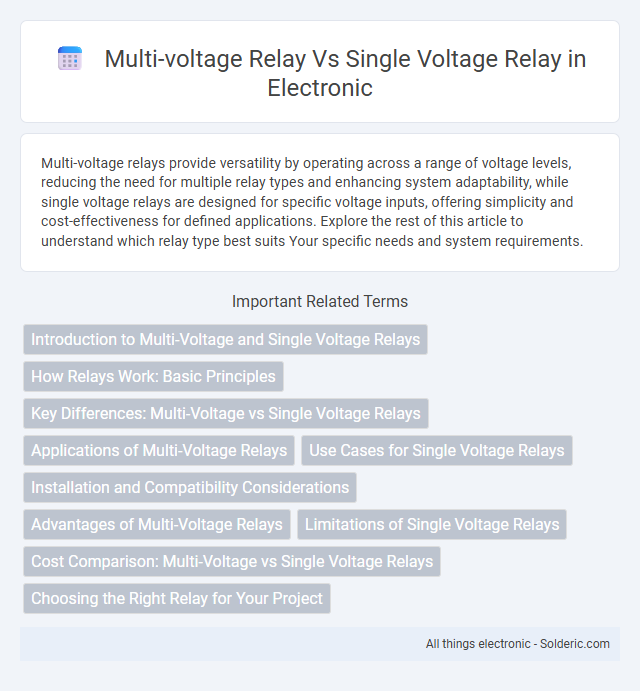Multi-voltage relays provide versatility by operating across a range of voltage levels, reducing the need for multiple relay types and enhancing system adaptability, while single voltage relays are designed for specific voltage inputs, offering simplicity and cost-effectiveness for defined applications. Explore the rest of this article to understand which relay type best suits Your specific needs and system requirements.
Comparison Table
| Feature | Multi-Voltage Relay | Single Voltage Relay |
|---|---|---|
| Voltage Compatibility | Supports multiple voltage levels | Supports only one specific voltage |
| Application Flexibility | High - adaptable to various systems | Low - limited to specific voltage systems |
| Cost | Typically higher due to complexity | Generally lower and simpler design |
| Installation | Requires voltage selection or auto-detection | Simple, direct installation |
| Maintenance | Requires careful voltage setting verification | Minimal, straightforward maintenance |
| Reliability | May vary based on voltage range and complexity | Highly reliable due to fixed voltage operation |
| Use Cases | Versatile for multiple voltage systems and environments | Specific to single-voltage control circuits |
Introduction to Multi-Voltage and Single Voltage Relays
Multi-voltage relays operate efficiently across a broad range of input voltages, enhancing flexibility in various electrical systems, while single voltage relays are designed to function at a specific voltage level, ensuring precise and stable performance. Understanding the key differences in voltage compatibility can help optimize your system's reliability and reduce the need for multiple relay types. Choosing between multi-voltage and single voltage relays depends on the application requirements, cost considerations, and environmental conditions.
How Relays Work: Basic Principles
Relays operate by using an electromagnetic coil to open or close electrical contacts, allowing control of a high-voltage circuit with a low-voltage signal. Multi-voltage relays incorporate multiple coils or adaptable coil designs to function across various input voltages, enhancing versatility compared to single voltage relays, which are optimized for a specific voltage. Your choice between these relays depends on the required voltage range and the application's need for flexibility or simplicity.
Key Differences: Multi-Voltage vs Single Voltage Relays
Multi-voltage relays support multiple input voltage ranges, offering greater flexibility for applications requiring varied power sources, while single voltage relays operate only within a fixed voltage specification, ensuring simplicity and cost-effectiveness. The key difference lies in adaptability; multi-voltage relays can seamlessly handle fluctuating or diverse voltage levels, reducing the need for multiple relay types in your system. Single voltage relays provide reliability and precision in environments with stable voltage requirements, minimizing complexity and maintenance.
Applications of Multi-Voltage Relays
Multi-voltage relays are commonly used in industrial automation, power distribution, and control systems where devices must operate reliably across a range of voltage inputs. These relays offer enhanced flexibility for equipment that encounters fluctuating or multiple voltage sources, such as in renewable energy systems, motor control centers, and electrical panels supporting diverse machinery. Their adaptability reduces the need for multiple relay types, simplifying inventory and maintenance in complex electrical networks.
Use Cases for Single Voltage Relays
Single voltage relays are widely used in applications where a consistent and fixed voltage supply is available, such as in household appliances, industrial machines, and automotive electrical systems. They offer reliable switching performance for circuits designed to operate at a specific voltage, ensuring optimal efficiency and protection. These relays are preferred in scenarios where simplicity, cost-effectiveness, and stable voltage conditions are critical.
Installation and Compatibility Considerations
Multi-voltage relays offer greater installation flexibility by supporting a wide range of input voltages, reducing the need for multiple relay types and simplifying inventory management. Single voltage relays require precise matching of voltage specifications to the application, increasing the risk of compatibility issues and installation errors. You can improve system reliability by choosing a relay type that aligns with your equipment's voltage requirements and installation environment.
Advantages of Multi-Voltage Relays
Multi-voltage relays offer enhanced flexibility by operating efficiently across a wide range of input voltages, reducing the need for multiple relay types in your system. Their adaptability simplifies inventory management and lowers maintenance costs while ensuring reliable performance in varying electrical environments. This makes multi-voltage relays ideal for applications where voltage levels fluctuate or are uncertain.
Limitations of Single Voltage Relays
Single voltage relays are limited by their fixed operational voltage, which restricts their use to specific applications and increases the need for multiple relay types in different voltage environments. This inflexibility can lead to higher inventory costs and complexity in system design. Your choice of relay should consider multi-voltage options for greater versatility and reduced maintenance challenges.
Cost Comparison: Multi-Voltage vs Single Voltage Relays
Multi-voltage relays typically cost more upfront than single voltage relays due to their complex design and versatility across various voltage levels. Single voltage relays offer a more budget-friendly option when your application requires operation at a fixed voltage, reducing unnecessary expenditure. Your choice between the two should factor in both initial costs and long-term flexibility needs to optimize overall value.
Choosing the Right Relay for Your Project
Selecting the right relay for your project depends on voltage requirements and flexibility; multi-voltage relays support multiple input voltages, making them ideal for applications with varying power sources or future upgrades. Single voltage relays are optimized for specific voltage ratings, offering high efficiency and reliability in stable, well-defined environments. Understanding your system's voltage conditions ensures you choose a relay that maximizes performance and longevity.
multi-voltage relay vs single voltage relay Infographic

 solderic.com
solderic.com